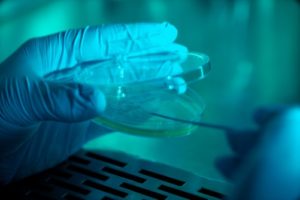
Diabetic foot ulcers can take up to 150 days to heal. A biomedical engineering team wants to reduce it to 21 days.
To drop the healing time, they plan to amplify what the body already does naturally: build layers of new tissue pumped up by nitric oxide.
In patients with diabetes, impaired nitric oxide production lessens the healing power of skin cells and the Centers for Disease Control and Prevention reports that 15 percent of Americans living with type 2 diabetes struggle with hard-to-heal foot ulcers. However, simply pumping up nitric oxide is not necessarily better. The long-term plan of Michigan Technological University researchers is to create nitric oxide-laden bandages that adjust the chemical release depending on the cell conditions.
To do that, they first have to determine what’s going on with nitric oxide in skin cells. Assessing nitric oxide under diabetic and normal conditions in human dermal fibroblast cells is the focus of the team’s paper, published in Medical Sciences.
Megan Frost, PhD,is the interim chair of the Department of Kinesiology and Integrative Physiology as well as an associate professor of biomedical engineering and an affiliated associate professor of materials science and engineering. She runs a polymeric biomaterials lab at Michigan Tech where she works on nitric oxide-releasing technology.
“Nitric oxide is a powerful healing chemical, but it’s not meant to be heavy-handed,” Frost says. “We’re looking at the profiles of healthy and diabetic cells to find a more nuanced way to recover wound function.”
As a wound heals, three types of skin cells step in. Macrophages are the first responders—and the most widely studied cells—that arrive within 24 hours of damage. Next, fibroblasts arrive, which are like the body’s engineers. They help lay down the extracellular matrix that makes it possible for the next cells, keratinocytes, to come in and do the heavy lifting and rebuilding.
“Wound healing is a complex, cell-mediated symphony of events, progressing through a series of predictable and overlapping stages,” Frost and her team wrote. When any part of that orchestra is out of tune, the whole process falls flat. Fibroblasts, which are not as well studied as macrophages in the healing process, are a key instrument and past studies have shown their delayed response in patients with diabetes may be a major factor in slow healing time.
That’s where nitric oxide steps in, a kind of chemical metronome to get the process back into the right rhythm. But the body’s dermal orchestra is not so simple—just as playing a metronome louder and louder isn’t necessarily going to make a musician’s timing improve, flooding a wound with nitric oxide isn’t a cure-all.
“The old approach is to add nitric oxide and sit back to see if it works,” Frost says. “What we’re finding is that it’s not enough to apply and leave; we have to keep tabs on how much nitric oxide is actually needed.”
Although the researchers are facing obstacles in their work, in a few years, they plan to have a working prototype for a nitric oxide-releasing bandage that could help heal one of healthcare’s toughest conditions in less than a month.
This article was adapted from information provided by Michigan Technological University.